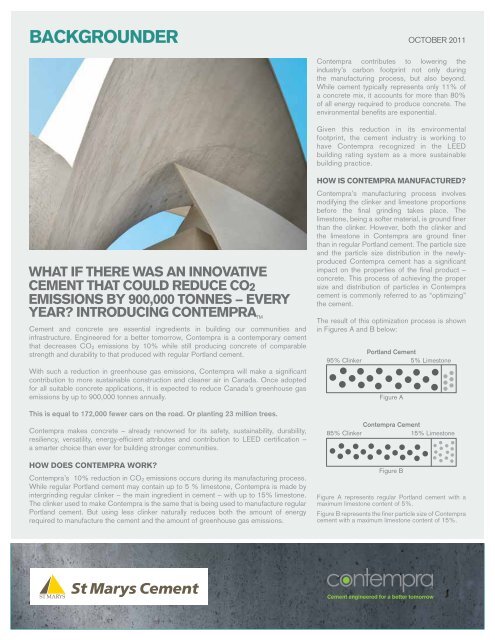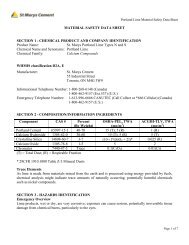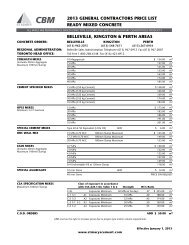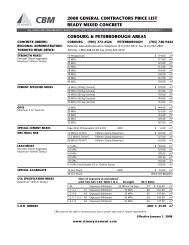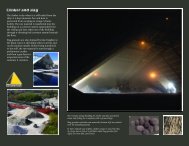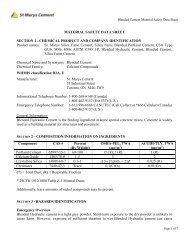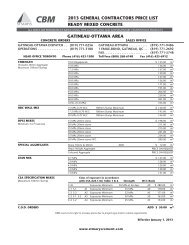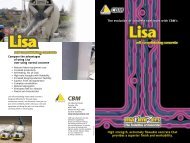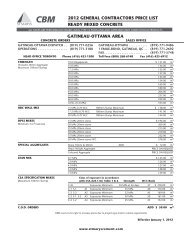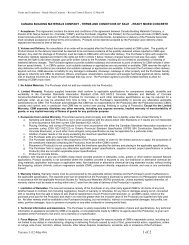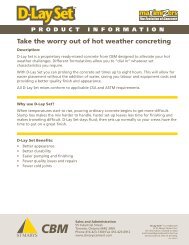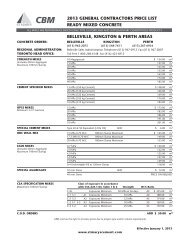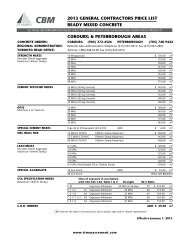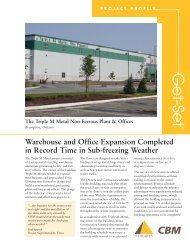(Contempra) Fact Sheet - St Marys Cement
(Contempra) Fact Sheet - St Marys Cement
(Contempra) Fact Sheet - St Marys Cement
Create successful ePaper yourself
Turn your PDF publications into a flip-book with our unique Google optimized e-Paper software.
BACKGROUNDER October 2011<br />
<strong>Contempra</strong> contributes to lowering the<br />
industry’s carbon footprint not only during<br />
the manufacturing process, but also beyond.<br />
While cement typically represents only 11% of<br />
a concrete mix, it accounts for more than 80%<br />
of all energy required to produce concrete. The<br />
environmental benefits are exponential.<br />
Given this reduction in its environmental<br />
footprint, the cement industry is working to<br />
have <strong>Contempra</strong> recognized in the LEED<br />
building rating system as a more sustainable<br />
building practice.<br />
WHAT IF THERE WAS AN INNOVATIVE<br />
CEMENT THAT COULD REDUCE CO2<br />
EMISSIONS BY 900,000 TONNES − EVERY<br />
YEAR? INTRODUCING CONTEMPRA TM<br />
<strong>Cement</strong> and concrete are essential ingredients in building our communities and<br />
infrastructure. Engineered for a better tomorrow, <strong>Contempra</strong> is a contemporary cement<br />
that decreases CO 2 emissions by 10% while still producing concrete of comparable<br />
strength and durability to that produced with regular Portland cement.<br />
With such a reduction in greenhouse gas emissions, <strong>Contempra</strong> will make a significant<br />
contribution to more sustainable construction and cleaner air in Canada. Once adopted<br />
for all suitable concrete applications, it is expected to reduce Canada’s greenhouse gas<br />
emissions by up to 900,000 tonnes annually.<br />
This is equal to 172,000 fewer cars on the road. Or planting 23 million trees.<br />
<strong>Contempra</strong> makes concrete – already renowned for its safety, sustainability, durability,<br />
resiliency, versatility, energy-efficient attributes and contribution to LEED certification –<br />
a smarter choice than ever for building stronger communities.<br />
HOW DOES CONTEMPRA WORK?<br />
<strong>Contempra</strong>’s 10% reduction in CO 2 emissions occurs during its manufacturing process.<br />
While regular Portland cement may contain up to 5 % limestone, <strong>Contempra</strong> is made by<br />
intergrinding regular clinker − the main ingredient in cement − with up to 15% limestone.<br />
The clinker used to make <strong>Contempra</strong> is the same that is being used to manufacture regular<br />
Portland cement. But using less clinker naturally reduces both the amount of energy<br />
required to manufacture the cement and the amount of greenhouse gas emissions.<br />
HOW IS CONTEMPRA MANUFACTURED?<br />
<strong>Contempra</strong>’s manufacturing process involves<br />
modifying the clinker and limestone proportions<br />
before the final grinding takes place. The<br />
limestone, being a softer material, is ground finer<br />
than the clinker. However, both the clinker and<br />
the limestone in <strong>Contempra</strong> are ground finer<br />
than in regular Portland cement. The particle size<br />
and the particle size distribution in the newlyproduced<br />
<strong>Contempra</strong> cement has a significant<br />
impact on the properties of the final product –<br />
concrete. This process of achieving the proper<br />
size and distribution of particles in <strong>Contempra</strong><br />
cement is commonly referred to as “optimizing”<br />
the cement.<br />
The result of this optimization process is shown<br />
in Figures A and B below:<br />
Portland <strong>Cement</strong><br />
95% Clinker 5% Limestone<br />
Figure A<br />
<strong>Contempra</strong> <strong>Cement</strong><br />
85% Clinker 15% Limestone<br />
Figure B<br />
Figure A represents regular Portland cement with a<br />
maximum limestone content of 5%.<br />
Figure B represents the finer particle size of <strong>Contempra</strong><br />
cement with a maximum limestone content of 15%.
BACKGROUNDER October 2011<br />
CONTEMPRA: LESS GHGs, YET<br />
comparable PERFORMANCE<br />
TO REGULAR PORTLAND CEMENT<br />
The cement industry has spent considerable<br />
resources in the last four years to optimize the<br />
properties of <strong>Contempra</strong>, previously referred<br />
to as Portland-limestone cement, to be<br />
comparable to regular Portland cement. On<br />
average, the <strong>Contempra</strong> clinker and limestone<br />
particles are smaller in size, producing a<br />
“particle packing effect” that increases the<br />
resulting strength of the concrete.<br />
Furthermore, the limestone is subjected<br />
to three quality assurance tests prior to<br />
manufacturing to ensure that <strong>Contempra</strong><br />
will provide suitable performance. These<br />
tests are for calcium carbonate content, clay<br />
content and total organic carbon content.<br />
Since <strong>Contempra</strong> is optimized to provide<br />
performance comparable to regular Portland<br />
cement manufactured in Canada, no<br />
significant changes are required to concrete<br />
mix designs when using <strong>Contempra</strong>.<br />
INNOVATIVE YET PROVEN<br />
The introduction of <strong>Contempra</strong> in Canada<br />
reflects the Canadian cement industry’s<br />
dedication to innovation and unwavering<br />
commitment to reducing its environmental<br />
footprint.<br />
By reducing the amount of clinker used in<br />
manufacturing cement – its main ingredient<br />
and most energy-intensive component – the<br />
industry has taken one of the most important<br />
steps in its recent history toward reducing<br />
the environmental impact of cement.<br />
While new to the Canadian market,<br />
<strong>Contempra</strong> has an extensive proven track<br />
record in Europe – where it is known as<br />
Portland-limestone cement – in a variety of<br />
commercial and residential applications for<br />
over 25 years.<br />
The European cement standard allows for<br />
Portland-limestone cement made with up to<br />
35% limestone content. The most popular<br />
cement sold in Europe today is Portlandlimestone<br />
cement with a limestone content of<br />
up to 20%. The 15% limestone limit applied<br />
to <strong>Contempra</strong> cement in Canada is well<br />
within the maximum limit of 35% permitted in<br />
European cement standards.<br />
EXTENSIVELY TESTED<br />
Before <strong>Contempra</strong>, then known as Portlandlimestone<br />
cement, was accepted by the<br />
Canadian <strong>St</strong>andards Association (CSA)<br />
A3001 and A23.1 standards – which<br />
regulate the cement manufacturing and use<br />
in Canada – the industry conducted extensive<br />
research and testing to verify its adequacy for<br />
the Canadian environment and construction<br />
industry. This included a thorough review of<br />
European literature on Portland-limestone<br />
cement, followed by comprehensive cement<br />
and concrete testing programs performed<br />
by various Canadian cement manufacturers<br />
and participating university researchers. The<br />
tests conclusively confirmed that optimized<br />
<strong>Contempra</strong> cement produces concrete with<br />
strength and durability properties equal to<br />
that produced using regular Portland cement.<br />
Field trials carried out in the harsher climates<br />
of Québec, Nova Scotia, and Ontario<br />
over two winters also demonstrated that<br />
<strong>Contempra</strong> produced concrete durability<br />
characteristics that compared very well with<br />
concrete using regular Portland cement.<br />
ADOPTION IN CANADIAN BUILDING<br />
CODES<br />
<strong>Contempra</strong> is included under the name<br />
Portland-limestone cement in the CSA cement<br />
and concrete standards, now referenced in<br />
the 2010 National Building Code of Canada<br />
and approved for use in British Columbia,<br />
Manitoba, Ontario, Quebec, and Nova<br />
Scotia. It will be approved for use in the other<br />
provincial jurisdictions once they adopt the<br />
2010 NBCC, or update their references to<br />
the current cement and concrete standards.<br />
While the new carbon-efficient cement<br />
is not yet permitted in sulphate exposure<br />
environments, additional testing in this area<br />
is ongoing. Early results are promising and<br />
sulphate exposure restrictions may be lifted<br />
in future editions of the CSA A23.1 Concrete<br />
<strong>St</strong>andard.<br />
WIDELY AVAILABLE<br />
<strong>Contempra</strong> is widely available across Canada.<br />
about st marys cement GROUP<br />
<strong>St</strong> <strong>Marys</strong> <strong>Cement</strong> Inc. is a leading manufacturer of cement and related construction products in the Great Lakes Region of the<br />
United <strong>St</strong>ates and Canada.<br />
ST MARYS CEMENT<br />
55 Industrial <strong>St</strong>reet,<br />
Toronto, Ontario M4G 3W9<br />
416-696-4425 or 1-800-268-6148<br />
www.stmaryscement.com


